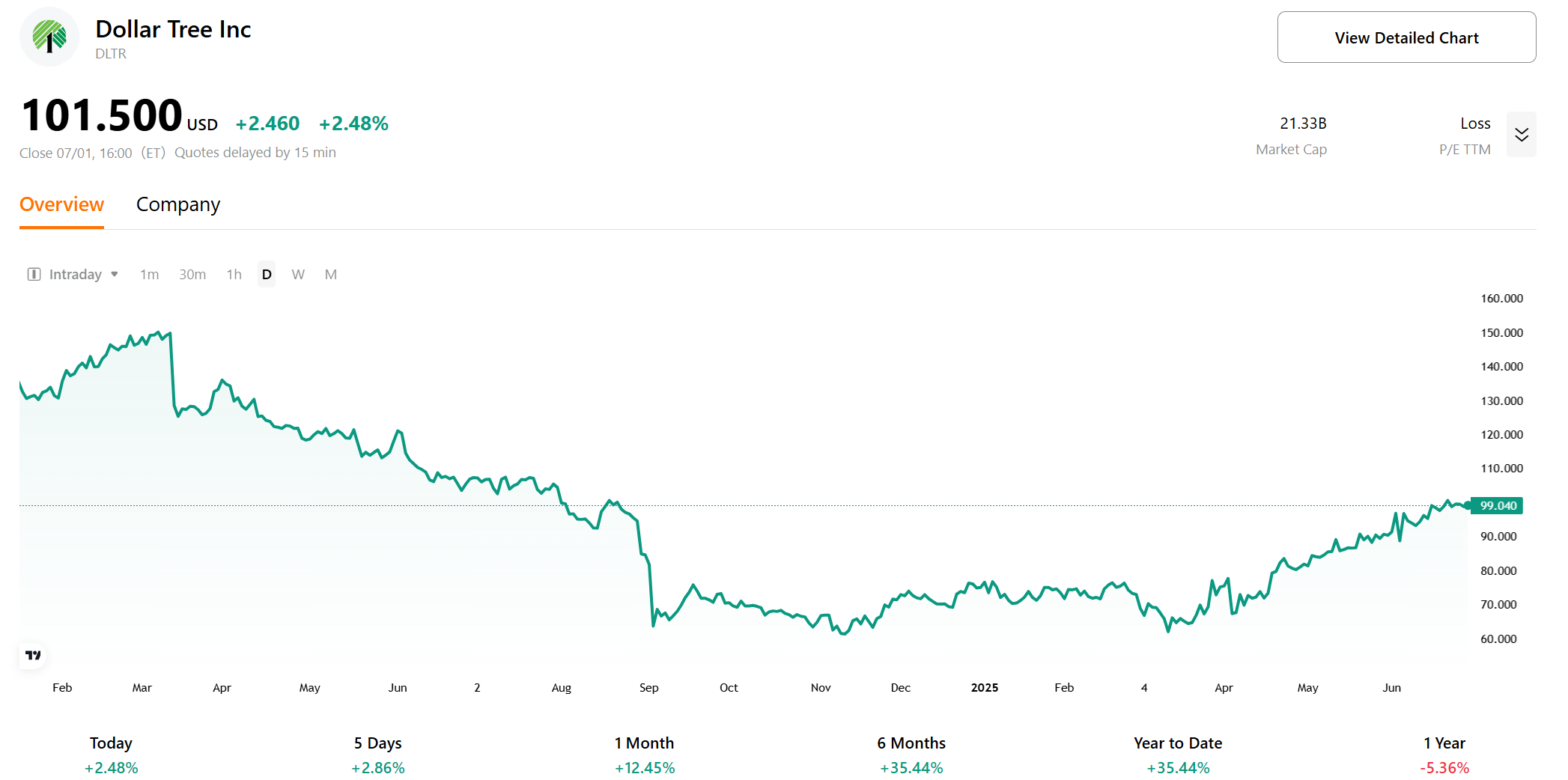Dollar Tree: Undervalued with High Potential: Why Is Dollar Tree a Long-Term Investment Opportunity in Discount Retail?

.jpg)
Investment Thesis
TradingKey - Dollar Tree leverages its low-price strategy and strong brand to maintain a competitive edge in the discount retail market. To focus on core operations, reduce costs, and boost profitability, the company divested Family Dollar, redirecting efforts toward high-return projects, implementing a multi-price strategy, and accelerating digital transformation to unlock growth potential. Its current price-to-earnings ratio, below the industry average, suggests an attractive valuation (fair value estimated at $120.21-$179.06). Despite intensifying competition and supply chain risks, easing inflation and e-commerce growth provide momentum for long-term success.

Source: TradingKey
.png)
Source: DollarTree, TradingKey
Company Overview
Dollar Tree, Inc. is a leading discount retail chain headquartered in Chesapeake, Virginia, USA, founded in 1986. The company operates approximately 9,000 stores across the United States and Canada under the Dollar Tree brand, offering a wide range of low-cost products, including daily necessities, groceries, and seasonal items. As a Fortune 500 company, Dollar Tree holds a significant position in the discount retail industry. In recent years, the company has enhanced its competitiveness through store expansion, pricing adjustments to address inflationary pressures, and ongoing efforts to optimize its supply chain and advance digital transformation, aiming to improve operational efficiency, boost profitability, and increase shareholder returns. On March 26, 2025, Dollar Tree announced the sale of its Family Dollar business, with the transaction expected to be completed in the second quarter of 2025.
Competitor Analysis
- Industry Overview: The discount retail industry, particularly the dollar store segment, focuses on providing low-cost goods to budget-conscious consumers. In recent years, driven by inflation and economic pressures, consumers have increasingly turned to discount options, fueling robust market growth. The market size is projected to grow from $464.53 billion in 2024 to $505.72 billion in 2025, with a compound annual growth rate (CAGR) of 8.9%. Over the coming years, the discount retail market is expected to continue expanding, reaching $701.68 billion by 2029, with a CAGR of 8.5%. Key growth drivers include intensifying online retail competition and rising internet penetration. However, the industry faces potential risks such as supply chain disruptions and tariff fluctuations.
%20.png)
Source: thebusinessresearch
- Competitive Landscape: Dollar Tree faces competition from Dollar General, Walmart, Aldi, Lidl, and Ross Stores. Dollar General, with over 19,000 stores, targets rural and small-town markets, leveraging an extensive store network, low-cost operations, and an efficient supply chain to offer convenience and low prices. Walmart, a retail giant, competes with discount retailers through its “Everyday Low Price” strategy, particularly in groceries and daily essentials. Aldi and Lidl, European discount retailers, are expanding in the U.S. with low prices and high-quality fresh produce, challenging Dollar Tree’s grocery segment. Ross Stores focuses on discounted apparel and home goods, appealing to cost-conscious consumers.
- Competitive Advantage: Dollar Tree operates as a challenger in the discount retail industry, leveraging its iconic fixed-price model to attract price-sensitive consumers. Following the sale of Family Dollar, its store count decreased from approximately 17,000 to about 9,000, resulting in a reduced market share. Although smaller in store count and scale compared to Dollar General, Dollar Tree maintains a competitive edge through strong brand recognition and operational efficiency. By optimizing its supply chain and streamlining SKUs, the company has significantly improved its gross and operating margins. Additionally, its adoption of a multi-price strategy (e.g., Dollar Tree Plus!) to expand product offerings and digital transformation efforts, such as partnerships with Instacart, have helped bridge the gap in market share.
.png)
Source: DollarTree, TradingKey
Revenue Breakdown
Dollar Tree's revenue primarily stems from three key categories: Consumable (Consumables), Variety (Diverse Goods), and Seasonal (Seasonal Goods).
- Consumables: This category includes everyday essentials such as food, beverages, and beauty products, with demand relatively unaffected by economic cycles. Even during inflation or economic downturns, consumers continue to meet basic living expenses, providing a stable demand foundation. As the primary revenue driver, Consumables exhibits consistent growth with minimal volatility. Dollar Tree's fixed low-price model creates a competitive edge in this category, particularly appealing to consumers seeking value in small-pack products, setting it apart from other retailers.
- Diverse Goods: This category encompasses a wide range of products, including party supplies, toys, stationery, and home décor, offering a unique "treasure-hunt" shopping experience. Dollar Tree enhances customer engagement by regularly introducing new items and employing a "frequent refresh" strategy to encourage repeat purchases. As the second-largest revenue source, Variety shows steady growth with occasional fluctuations tied to new product launches. The combination of low prices and diverse offerings makes it an ideal choice for impulse buys, especially among budget-conscious consumers.
- Seasonal Goods: This category includes holiday decorations (e.g., Christmas and Halloween items), with sales heavily dependent on seasonal festivities and marked by significant volatility. The time-sensitive nature of these products requires precise demand forecasting and inventory management. Any overstock or stockouts can lead to revenue fluctuations, impacting the category's profit margins.
.png)
Source: Dollar Tree, TradingKey
Growth Potential
- Macro Factors: An improvement in inflation could attract mid-to-high-income customers to increase spending at Dollar Tree, further expanding its customer base. If inflation continues to ease, the Federal Reserve is expected to implement larger interest rate cuts, alleviating Dollar Tree's financial pressure. The released capital could accelerate new store openings, enhancing market coverage.
- New Businesses and Products: Following the divestiture of Family Dollar, Dollar Tree has redirected capital toward high-return initiatives, such as a multi-price strategy, introducing $3 and $5 price points to broaden its product range and boost average basket size. The company continues to optimize its product mix, adding new SKUs in Consumable and Variety categories, including healthy snacks, home décor, and sustainable products, to align with evolving consumer preferences. However, failure to keep pace with trends (e.g., eco-friendly demand) or improve Seasonal category efficiency could hinder growth potential.
- E-commerce Development: E-commerce integration is a key trend in the discount retail sector, though Dollar Tree’s e-commerce capabilities remain relatively weak, relying primarily on its 2024 partnership with Instacart for online ordering and delivery. Looking ahead, the company plans to invest $1.2 to $1.3 billion to open 400 new stores and rebuild distribution centers, strengthening its digital platform. Management expects the e-commerce revenue share to gradually increase by 2025.
Overall, Dollar Tree’s future growth potential is substantial, driven by improving inflation, lower interest rates, strategic investments, and product diversification. Further advancements in e-commerce and AI will provide additional momentum for long-term growth. Despite short-term economic and competitive risks, the potential outweighs the risks, making it appealing for long-term investors. With a current P/E ratio of 19.53—below the industry average of 32.81—the company appears undervalued. Investors should monitor progress in e-commerce and AI, as well as macroeconomic developments.
.png)
Source: Dollar Tree, TradingKey
Valuation
Based on a three-year discounted cash flow (DCF) model, Dollar Tree's enterprise value (EV) is estimated at $25.855 billion to $38.512 billion, comprising a present value (PV) of $2.961 billion to $3.870 billion and a terminal value (TV) of $24.547 billion to $36.295 billion. The model uses a revenue growth rate of -9.99% to 1.00%, an operating margin of 7.78% to 8.15%, and a discount rate based on U.S. Treasury yields of 3.84% to 4.20% plus a 2% premium. After deducting net debt of $21.747 billion (total debt of $34.312 billion minus cash and short-term investments of $12.565 billion) from the EV and dividing by 215 million outstanding shares, the fair value range is $120.21 to $179.06. This valuation reflects Dollar Tree's competitive edge in the discount retail market but is tempered by revenue volatility and the scale reduction following the Family Dollar divestiture, with future growth potential hinging on its multi-price strategy and digital transformation execution.
Risk
- Intensifying Competition: Competitors such as Dollar General, Walmart, and Aldi are expanding their scale and leveraging low-price strategies to capture market share, potentially eroding Dollar Tree's customer base.
- Supply Chain Disruption: Global supply chain instability or rising costs (e.g., increased transportation expenses) could compress profit margins, particularly impacting the low-price-dependent Consumable category.
- Impact of Family Dollar Divestiture: The 2025 divestiture of Family Dollar, resulting in a reduction in store count and market share, may weaken Dollar Tree's overall competitiveness in the discount retail industry.
- Seasonal Category Volatility: Revenue from the Seasonal category is highly dependent on holidays, and missteps in inventory management or inaccurate demand forecasting for festive periods could lead to sales fluctuations and profit losses.
.jpg)







